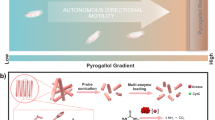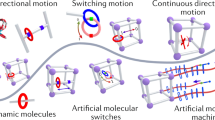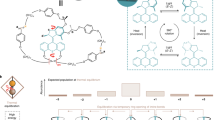Abstract
A variety of microsystems have been developed that harness energy and convert it to mechanical motion. Here we have developed new autonomous biochemical motors by integrating a metal–organic framework (MOF) and self-assembling peptides. The MOF is applied as an energy-storing cell that assembles peptides inside nanoscale pores of the coordination framework. The nature of peptides enables their assemblies to be reconfigured at the water/MOF interface, and thus converted to fuel energy. Reorganization of hydrophobic peptides can create a large surface-tension gradient around the MOF that can efficiently power its translational motion. As a comparison, the velocity normalized by volume for the diphenylalanine–MOF particle is faster and the kinetic energy per unit mass of fuel is more than twice as great as that for previous gel motor systems. This demonstration opens the route towards new applications of MOFs and reconfigurable molecular self-assembly, possibly evolving into a smart autonomous motor capable of mimicking swimming bacteria and, with integrated recognition units, harvesting target chemicals.
This is a preview of subscription content, access via your institution
Access options
Subscribe to this journal
Receive 12 print issues and online access
$259.00 per year
only $21.58 per issue
Buy this article
- Purchase on Springer Link
- Instant access to full article PDF
Prices may be subject to local taxes which are calculated during checkout



Similar content being viewed by others
References
Hanczyc, M. M., Toyota, T., Ikegami, T., Packard, N. & Sugawara, T. Fatty acid chemistry at the oil–water interface: Self-propelled oil droplets. J. Am. Chem. Soc. 129, 9386–9391 (2007).
Sumino, Y., Magome, N., Hamada, T. & Yoshikawa, K. Self-running droplet: Emergence of regular motion from nonequilibrium noise. Phys. Rev. Lett. 94, 068301 (2005).
Nakata, S. & Murakami, M. Self-motion of a camphor disk on an aqueous phase depending on the alkyl chain length of sulfate surfactants. Langmuir 26, 2414–2417 (2010).
Marangoni, C. Ueber die Ausbreitung der Tropfen einer Flüssigkeit auf der Oberfläche einer anderen. Ann. Phys. 219, 337–354 (1871).
Gong, J. P., Matsumoto, S., Uchida, M., Isogai, N. & Osada, Y. Motion of polymer gels by spreading organic fluid on water. J. Phys. Chem. 100, 11092–11097 (1996).
Verkhovsky, A. B., Svitkina, T. M. & Borisy, G. G. Self-polarization and directional motility of cytoplasm. Curr. Biol. 9, 11–20 (1999).
Miyata, H., Nishiyama, S., Akashi, K. & Kinosita, K. J. Protrusive growth from giant liposomes driven by actin polymerization. Proc. Natl Acad. Sci. USA 96, 2048–2053 (1999).
Upadhyaya, A. & van Oudenaarden, A. Biomimetic systems for studying actin-based motility. Curr. Biol. 13, R734–R744 (2003).
Upadhyaya, A., Chabot, J. R., Andreeva, A., Samadani, A. & van Oudenaarden, A. Probing polymerization forces by using actin-propelled lipid vesicles. Proc. Natl Acad. Sci. USA 100, 4521–4526 (2003).
Yaghi, O. M. et al. Reticular synthesis and the design of new materials. Nature 423, 705–714 (2003).
Ferey, G. Hybrid porous solids: Past, present, future. Chem. Soc. Rev. 37, 191–214 (2008).
Bradshaw, D., Claridge, J. B., Cussen, E. J., Prior, T. J. & Rosseinsky, M. J. Design, chirality, and flexibility in nanoporous molecular-based materials. Acc. Chem. Res. 38, 273–282 (2005).
Murray, L. J., Dinca, M. & Long, J. R. Hydrogen storage in metal–organic frameworks. Chem. Soc. Rev. 38, 1294–1314 (2009).
Kitagawa, S., Kitaura, R. & Noro, S. Functional porous coordination polymers. Angew. Chem. Int. Ed. 43, 2334–2375 (2004).
Li, J. R., Kuppler, R. J. & Zhou, H. C. Selective gas adsorption and separation in metal–organic frameworks. Chem. Soc. Rev. 38, 1477–1504 (2009).
Forster, P. M. & Cheetham, A. K. Hybrid inorganic-organic solids: An emerging class of nanoporous catalysts. Top. Catal. 24, 79–86 (2003).
Lee, J. et al. Metal-organic framework materials as catalysts. Chem. Soc. Rev. 38, 1450–1459 (2009).
Oh, M. & Mirkin, C. A. Chemically tailorable colloidal particles from infinite coordination polymers. Nature 438, 651–654 (2005).
Uemura, T., Yanai, N. & Kitagawa, S. Polymerization reactions in porous coordination polymers. Chem. Soc. Rev. 38, 1228–1236 (2009).
Hartgerink, J. D., Beniash, E. & Stupp, S. I. Self-assembly and mineralization of peptide-amphiphile nanofibers. Science 294, 1684–1688 (2001).
Reches, M. & Gazit, E. Casting metal nanowires within discrete self-assembled peptide nanotubes. Science 300, 625–627 (2003).
Bellomo, E. G., Wyrsta, M. D., Pakstis, L., Pochan, D. J. & Deming, T. J. Stimuli-responsive polypeptide vesicles by conformation-specific assembly. Nature Mater. 3, 244–248 (2004).
Pouget, E. et al. Hierarchical architectures by synergy between dynamical template self-assembly and biomineralization. Nature Mater. 6, 434–439 (2007).
Ura, Y., Beierle, J. M., Leman, L. J., Orgel, L. E. & Ghadiri, M. R. Self-assembling sequence-adaptive peptide nucleic acids. Science 325, 73–77 (2009).
Banwell, E. F. et al. Rational design and application of responsive α-helical peptide hydrogels. Nature Mater. 8, 596–600 (2009).
Mershin, A., Cook, B., Kaiser, L. & Zhang, S. G. A classic assembly of nanobiomaterials. Nature Biotech. 23, 1379–1380 (2005).
Williams, R. J. et al. Enzyme-assisted self-assembly under thermodynamic control. Nature Nanotech. 4, 19–24 (2009).
McKinlay, A. C. et al. BioMOFs: Metal-organic frameworks for biological and medical applications. Angew. Chem. Int. Ed. 49, 6260–6266 (2009).
Rabone, J. et al. An adaptable peptide-based porous material. Science 329, 1053–1057 (2010).
Mitsumata, T., Ikeda, K., Gong, J. P. & Osada, Y. Solvent-driven chemical motor. Appl. Phys. Lett. 73, 2366–2368 (1998).
Seki, K. & Mori, W. Synthesis and characterization of microporous coordination polymers with open frameworks. J. Phys. Chem. B 106, 1380–1385 (2002).
Uemura, T. et al. Unveiling thermal transitions of polymers in subnanometre pores. Nature Commun. 1, 83–91 (2010).
Uemura, T., Ono, Y., Kitagawa, K. & Kitagawa, S. Radical polymerization of vinyl monomers in porous coordination polymers: Nanochannel size effects on reactivity, molecular weight, and stereostructure. Macromolecules 41, 87–94 (2008).
Uemura, T., Ono, Y., Hijikata, Y. & Kitagawa, S. Functionalization of coordination nanochannels for controlling tacticity in radical vinyl polymerization. J. Am. Chem. Soc. 132, 4917–4924 (2010).
Dos Santos, F. D. & Ondarçuhu, T. Free-running droplets. Phys. Rev. Lett. 75, 2972–2975 (1995).
Lheveder, C. et al. A new Brewster angle microscope. Rev. Sci. Instrum. 69, 1446–1450 (1998).
Yanai, N. et al. Fabrication of two-dimensional polymer arrays: Template synthesis of polypyrrole between redox-active coordination nanoslits. Angew. Chem. Int. Ed. 47, 9883–9886 (2008).
Uemura, T. et al. Highly photoconducting pi-stacked polymer accommodated in coordination nanochannels. J. Am. Chem. Soc. 134, 8360–8363 (2012).
Reches, M. & Gazit, E. Controlled patterning of aligned self-assembled peptide nanotubes. Nature Nanotech. 1, 195–200 (2006).
Görbitz, C. H. Nanotube formation by hydrophobic dipeptides. Chem. Eur. J. 7, 5153–5159 (2001).
Görbitz, C. H. The structure of nanotubes formed by diphenylalanine, the core recognition motif of Alzheimer’s β-amyloid polypeptide. Chem. Commun. 2332–2334 (2006).
Wolde, P. R. t. & Frenkel, D. enhancement of protein crystal nucleation by critical density fluctuations. Science 277, 1975–1978 (1997).
Lagzi, I., Soh, S., Wesson, P. J., Browne, K. P. & Grzybowski, B. a. Maze solving by chemotactic droplets. J. Am. Chem. Soc. 132, 1198–1199 (2010).
Acknowledgements
All of the work apart from chemical syntheses of MOFs was supported by the US Department of Energy, Office of Basic Energy Sciences, Division of Materials Sciences and Engineering under Award No. DE-FG-02-01ER45935. Hunter College infrastructure is supported by the National Institutes of Health, the RCMI program (G12 MD007599). Chemical syntheses of MOFs in Kyoto were supported by Grant-in-Aid for Scientific Research on Innovative Area ‘Emergence in Chemistry’ from MEXT. H.M. acknowledges the Japan Society for the Promotion of Science (JSPS) for supporting his collaboration at the Institute for Integrated Cell-Material Sciences (iCeMS) in Kyoto University through the Invitation Fellowship Program for Research in Japan. Y.I. and H.M. thank R. Tu (City College of New York) for the use of and assistance with Brewster angle microscopy.
Author information
Authors and Affiliations
Contributions
H.M. and Y.I. conceived and coordinated the project. Y.I., T.U. and H.M. wrote the paper. G.W., T.U. and H.M. synthesized and analysed the materials. Y.I. and H.M. performed the motion and microscopic studies on samples. Y.I., G.W., T.U., S.K. and H.M. discussed the results and commented on the manuscript.
Corresponding author
Ethics declarations
Competing interests
The authors declare no competing financial interests.
Supplementary information
Supplementary Information
Supplementary Information (PDF 4264 kb)
Supplementary Information
Supplementary Movie S1 (MOV 546 kb)
Supplementary Information
Supplementary Movie S2 (MOV 161 kb)
Supplementary Information
Supplementary Movie S3 (MOV 13063 kb)
Supplementary Information
Supplementary Movie S4 (MOV 3448 kb)
Supplementary Information
Supplementary Movie S5 (MOV 159 kb)
Supplementary Information
Supplementary Movie S6 (MOV 479 kb)
Rights and permissions
About this article
Cite this article
Ikezoe, Y., Washino, G., Uemura, T. et al. Autonomous motors of a metal–organic framework powered by reorganization of self-assembled peptides at interfaces. Nature Mater 11, 1081–1085 (2012). https://doi.org/10.1038/nmat3461
Received:
Accepted:
Published:
Issue Date:
DOI: https://doi.org/10.1038/nmat3461
This article is cited by
-
Hierarchical Self-Assembly of Injectable Alginate Supramolecular Nanofibril Hydrogels for Hemostasis In Vivo
Advanced Fiber Materials (2024)
-
Peptide-derived coordination frameworks for biomimetic and selective separation
Analytical and Bioanalytical Chemistry (2023)
-
Explaining chemical clues of metal organic framework-nanozyme nano-/micro-motors in targeted treatment of cancers: benchmarks and challenges
Journal of Nanobiotechnology (2022)
-
Photopatterned microswimmers with programmable motion without external stimuli
Nature Communications (2021)
-
Biocatalytic cascades operating on macromolecular scaffolds and in confined environments
Nature Catalysis (2020)



